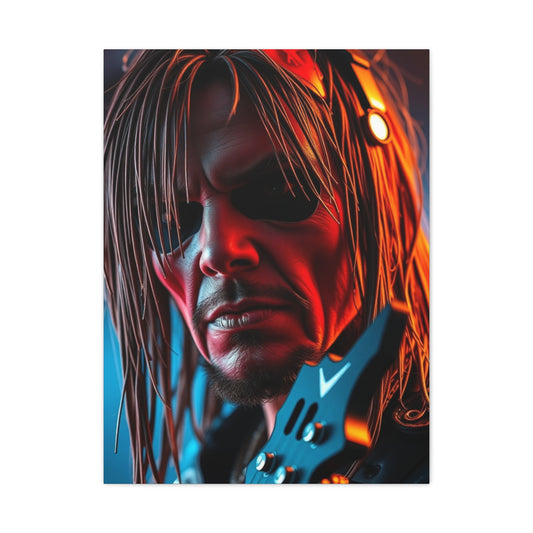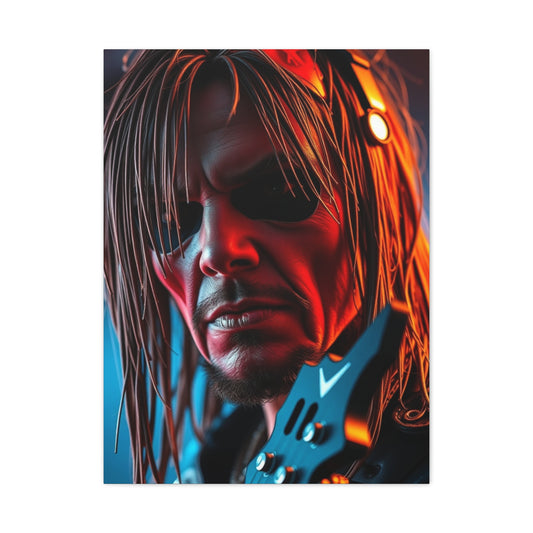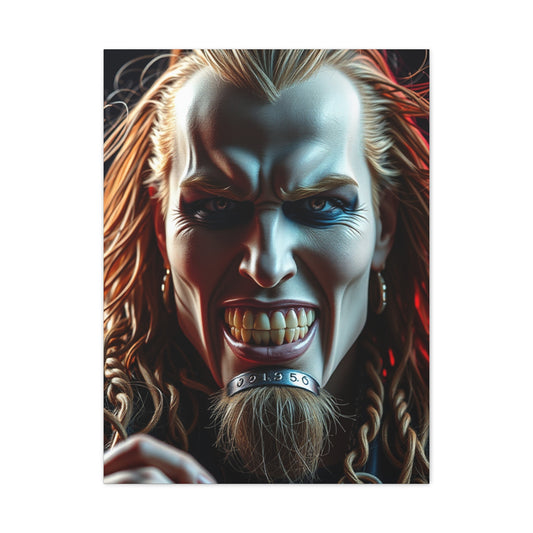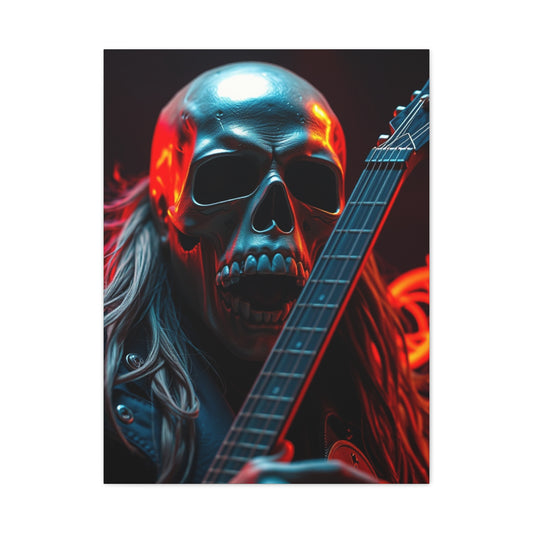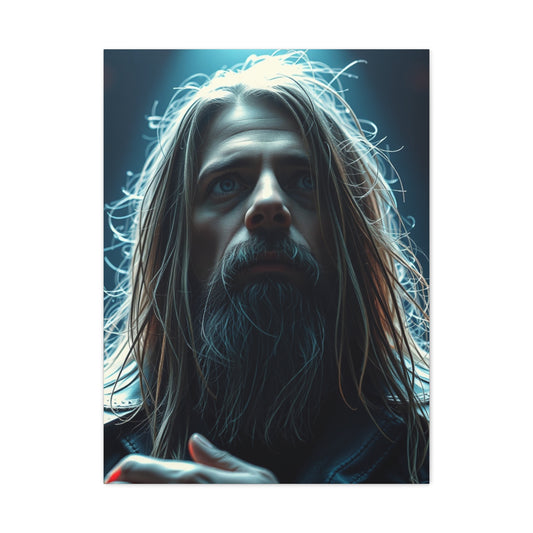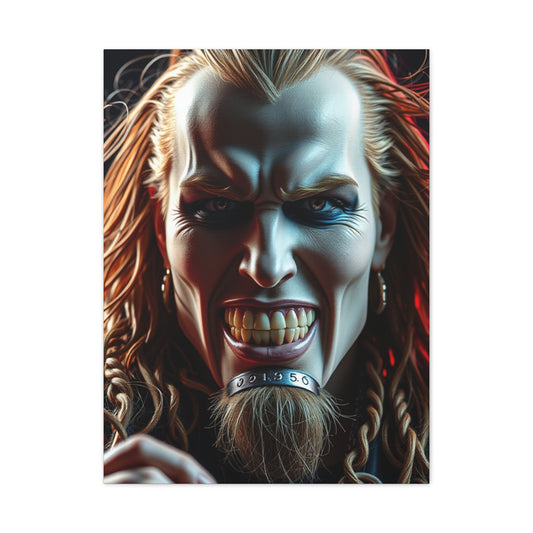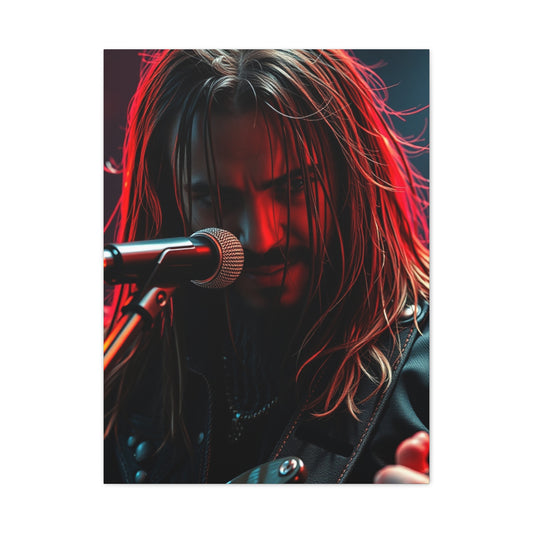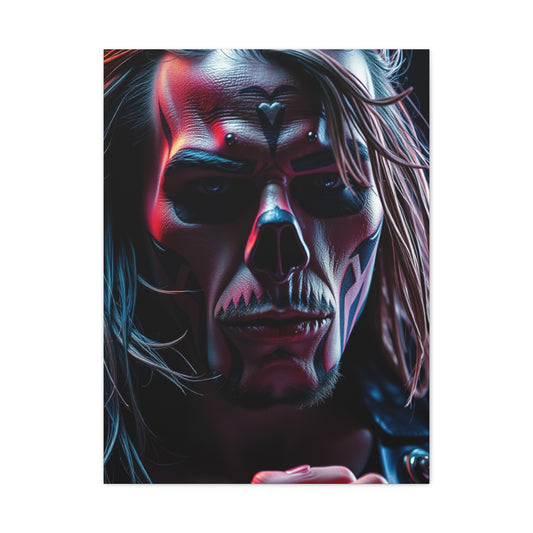Transform Your Space with Heavy Metal Music Wall Art and Modern Pop Art Prints
The world of art has always been in perpetual flux, oscillating between the esoteric and the accessible, the classical and the avant-garde. Among the myriad movements that have punctuated the timeline of modern art, few have had an impact as immediate, ubiquitous, and culturally resonant as pop art. With its audacious colors, iconic imagery, and playful critique of consumer culture, pop art redefined the boundaries of artistic expression. This movement did not merely decorate walls—it punctuated society with a vibrant commentary on the zeitgeist, transforming everyday objects into portals of aesthetic contemplation.
Pop art did not emerge in a vacuum. Its roots trace back to the post-war periods of Britain and the United States, where artists confronted a world reshaped by industrialization, mass media, and consumerism. The somber, introspective tendencies of earlier mid-century art were giving way to something more jubilant, irreverent, and visually assertive. Artists began to explore the confluence of art, popular culture, and commerce, daring to question what could be considered worthy of aesthetic admiration. This burgeoning curiosity catalyzed the birth of a movement that would redefine the cultural landscape.
At its core, pop art is a celebration of the quotidian. It elevates objects, icons, and images from the commonplace into a lexicon of visual significance. Whether it is a soup can, a comic book panel, or a celebrity portrait, the movement treats these artifacts with a reverence usually reserved for classical subjects. The audacity of pop art lies in this recontextualization, transforming the banal into the transcendent. It invites observers to reconsider their relationship with everyday life, challenging the notion that profound artistic experiences are reserved for the elite or esoteric.
The inception of pop art is inextricably linked to a cohort of pioneering artists who were both intellectual provocateurs and visual innovators. Richard Hamilton, often regarded as one of the progenitors of British pop art, explored the intricacies of modern consumer culture with a satirical lens. His collages, meticulously crafted from cut-outs of magazines and advertisements, dissected the promises and illusions of post-war domestic life. Hamilton’s work is emblematic of the analytical yet whimsical spirit of early pop art: an interplay of critique, fascination, and aesthetic delight.
Across the Atlantic, the movement gained a distinctly American dimension. The United States, a burgeoning superpower with an ever-expanding mass media landscape, provided fertile ground for pop art’s audacious ethos. Artists such as Andy Warhol embraced the machinery of mass production both conceptually and literally. Warhol’s repetitive imagery, often featuring iconic consumer products and celebrity portraits, mirrored the mechanical replication inherent in advertising and media. His work challenged viewers to question the nature of originality, artifice, and cultural obsession.
Parallel to Warhol’s endeavors, Roy Lichtenstein introduced the visual vernacular of comic books into the artistic mainstream. Employing Ben-Day dots, primary colors, and exaggerated expressions, Lichtenstein’s work blurred the boundary between high art and popular media. The dramatic, almost melodramatic, quality of his pieces underscores pop art’s fascination with spectacle and narrative. By translating ephemeral, mass-produced images into painstakingly crafted artworks, Lichtenstein highlighted the interplay between temporality, perception, and aesthetic permanence.
Claes Oldenburg contributed yet another dimension to the movement through his monumental sculptures of everyday items. By magnifying the ordinary to extraordinary proportions, he subverted expectations and injected humor into the discourse of art. Oldenburg’s works provoke delight and contemplation simultaneously, demonstrating the movement’s capacity to balance accessibility with intellectual provocation. His oversized hamburgers, pencils, and household objects epitomize the whimsical exaggeration that became synonymous with pop art.
Pop art’s ascendancy was not merely a stylistic innovation; it was a cultural phenomenon. It responded to the rapid expansion of mass media, the commodification of art, and society’s growing obsession with celebrity and consumerism. By integrating the visual language of advertisements, films, and popular products, pop artists created a lexicon that was immediately recognizable yet intellectually stimulating. Their audacious use of color, repetition, and collage disrupted traditional hierarchies, inviting audiences from all walks of life to engage with art on new terms.
The aesthetic vocabulary of pop art is as distinctive as it is versatile. Bold, saturated colors dominate the canvas, often juxtaposed with graphic lines and patterns. Repetition serves as both a formal device and a conceptual critique, emphasizing the ubiquity and omnipresence of media imagery. Collage, montage, and assemblage allow artists to weave disparate elements into cohesive narratives, highlighting both cultural connectivity and the fragmentation of modern life. This visual lexicon is not only striking but intellectually engaging, revealing layers of meaning upon closer examination.
One of the defining aspects of pop art is its dialogic relationship with the viewer. Unlike previous movements that demanded contemplation from a distance, pop art beckons engagement. It provokes recognition, nostalgia, amusement, and sometimes discomfort. The movement thrives on its capacity to straddle the line between the familiar and the provocative, offering viewers a playful yet incisive lens through which to interpret their world. By translating everyday experience into a heightened visual lexicon, pop art democratized access to aesthetic discourse.
The cultural resonance of pop art extends far beyond the confines of the gallery. Its influence permeated fashion, design, advertising, and even music. Pop art’s iconography became a universal shorthand, recognizable across geographic and demographic boundaries. From patterned textiles to printed ephemera, the aesthetic principles of pop art infiltrated daily life, reflecting its capacity to dissolve the barriers between art and lived experience. In doing so, the movement established itself not merely as a historical phenomenon but as an enduring framework for understanding contemporary visual culture.
Pop art’s impact on interior design cannot be overstated. The same audacious colors and graphic patterns that characterized canvases found their way into furniture, textiles, and decorative objects. By integrating pop art into living spaces, designers could inject energy, personality, and an irreverent sense of playfulness. The movement’s iconoclastic ethos encouraged experimentation: vibrant prints could be juxtaposed with minimalist furniture, or comic-inspired motifs could be paired with industrial finishes, creating environments that were both visually stimulating and conceptually layered.
Despite its playful veneer, pop art also carries an undercurrent of social commentary. The movement often critiques materialism, celebrity obsession, and the homogenization of culture. By repurposing and exaggerating familiar symbols, pop artists invite viewers to reconsider the cultural narratives embedded in everyday imagery. This duality—entertainment and critique, delight and reflection—is what lends pop art its enduring appeal. It is art that is both immediately gratifying and intellectually rewarding.
Pioneers and Icons: The Architects of Pop Art
Pop art’s evolution is inseparable from the pioneering visionaries who championed the movement and transformed it into a cultural phenomenon. These artists not only redefined aesthetics but also reshaped the dialogue between art, commerce, and society. By drawing from mass media, consumer goods, and popular culture, they established a visual language that was both playful and incisive. Understanding their contributions offers invaluable insight into the depth, innovation, and enduring influence of pop art.
Richard Hamilton: The Analytical Visionary
Richard Hamilton, often considered the progenitor of British pop art, approached art with a unique blend of wit, intellect, and cultural sensitivity. His collages dissected post-war consumerism with precision, reflecting the emerging material culture of the mid-20th century. Hamilton’s most celebrated work, a collage portraying the modern domestic interior, juxtaposes everyday objects with aspirational imagery from advertisements and magazines.
Hamilton’s approach exemplifies pop art’s intellectual rigor. By incorporating elements of mass culture into his compositions, he questioned the distinctions between high and low art, revealing the constructed nature of cultural value. His work embodies a sophisticated awareness of societal trends while retaining an accessible, visually compelling aesthetic, making him a crucial figure in understanding the movement’s philosophical underpinnings.
Eduardo Paolozzi: The Mechanized Imagination
Eduardo Paolozzi contributed a distinctly modernist sensibility to pop art, merging technological fascination with cultural observation. Paolozzi’s collages and sculptures often explore the intricate relationship between humans and machines, reflecting post-war technological advancements and their societal impact. His works depict a world simultaneously enthralled and overwhelmed by industrial progress, often featuring robotic forms, mechanical components, and commercial ephemera.
Paolozzi’s art is characterized by its exuberant complexity, dense layering, and surreal juxtapositions. By integrating imagery from advertising, science fiction, and consumer culture, he established a visual lexicon that resonates with the mechanized pulse of modern life. His work underscores the movement’s ability to critique contemporary society while embracing playful experimentation and imaginative exuberance.
Andy Warhol: The Pop Icon
Andy Warhol’s name is virtually synonymous with pop art, yet his contributions extend far beyond celebrity recognition. Warhol’s artistry explored themes of mass production, consumerism, and fame, reflecting the cultural preoccupations of post-war America. His signature repetitive prints of soup cans, soda bottles, and iconic celebrities transformed banal objects into symbols of cultural obsession and aesthetic fascination.
Warhol’s studio, known as The Factory, functioned as both a creative incubator and a social hub, drawing musicians, actors, and fellow artists into a collaborative atmosphere. The Factory exemplified Warhol’s conceptual approach, where art was not merely a product of individual genius but a dynamic, participatory enterprise. His fascination with repetition, commodification, and mass media continues to influence contemporary visual culture and design.
Roy Lichtenstein: From Comics to Canvas
Roy Lichtenstein brought the dynamic energy of comic books into the artistic mainstream, transforming ephemeral illustrations into enduring masterpieces. His works employ bold outlines, primary colors, and Ben-Day dots to emulate the visual language of mass-produced imagery, bridging the gap between commercial art and high art.
One of Lichtenstein’s most iconic pieces, depicting a dramatic aerial combat scene, exemplifies his ability to elevate popular imagery into a realm of artistic sophistication. By appropriating and recontextualizing comic book panels, Lichtenstein interrogated notions of originality, narrative, and cultural hierarchy. His art demonstrates that the everyday and the sensational can coexist within a refined aesthetic framework, highlighting the conceptual breadth of pop art.
Claes Oldenburg: The Whimsical Monumentalist
Claes Oldenburg’s contributions to pop art lie in his playful manipulation of scale and form. By transforming mundane objects into oversized sculptures, he challenged conventional perceptions of materiality and meaning. His creations—ranging from colossal hamburgers to giant typewriters—invite viewers to reconsider the familiar with a sense of delight and curiosity.
Oldenburg’s work embodies the intersection of humor, commentary, and aesthetic innovation. By elevating everyday items to monumental proportions, he blurred the boundary between art and life, emphasizing the movement’s capacity for whimsy without sacrificing intellectual depth. His sculptures highlight pop art’s multidimensionality, demonstrating that the movement encompasses painting, collage, sculpture, and experiential installation alike.
Evolution and Diversification of the Movement
Following the initial breakthroughs of Hamilton, Paolozzi, Warhol, Lichtenstein, and Oldenburg, pop art underwent rapid diversification. Artists worldwide began experimenting with new media, subject matter, and techniques, expanding the movement’s scope beyond its original Anglo-American roots. The late 1960s and 1970s saw the emergence of pop-influenced photography, printmaking, and mixed-media installations, reflecting the movement’s adaptability and enduring appeal.
This period also witnessed the integration of pop art into commercial design, fashion, and architecture. The vibrant patterns, bold color schemes, and graphic motifs characteristic of the movement found expression in interiors, clothing, and consumer products, further blurring the line between art and everyday life. Pop art became a ubiquitous cultural force, influencing visual perception and aesthetic sensibilities across multiple domains.
Pop Art and Cultural Commentary
While often celebrated for its vibrancy and humor, pop art is equally significant for its incisive social commentary. By appropriating and exaggerating images from advertising, media, and popular culture, artists exposed the underlying mechanisms of consumerism, mass communication, and societal obsession with fame. These works function as both mirrors and magnifying lenses, reflecting cultural values while prompting critical engagement.
The duality of entertainment and critique is a hallmark of pop art. Its accessible imagery draws in viewers, while its conceptual undercurrents encourage contemplation and discourse. By transforming commercial symbols into artistic statements, pop art confronts assumptions about taste, value, and the social construction of desirability, making it simultaneously enjoyable and intellectually stimulating.
Expanding the Visual Vocabulary
Pop art introduced a visual vocabulary that remains distinctive and influential. The movement’s hallmark features—bold, saturated colors, dynamic patterns, and repeated imagery—create immediate impact while supporting layered interpretation. Collage and montage techniques enable artists to juxtapose disparate elements, highlighting both the interconnectedness and fragmentation of modern life.
The visual strategies pioneered by pop artists inform contemporary design practices, from graphic design to digital media. Their inventive use of composition, scale, and narrative remains a source of inspiration for artists seeking to integrate cultural critique with visual dynamism. Pop art’s lexicon continues to evolve, demonstrating the enduring adaptability of its principles.
The Global Reach of Pop Art
Although its origins are rooted in Britain and the United States, pop art rapidly transcended national boundaries. International artists adapted the movement to reflect local cultural phenomena, producing works that resonate with their unique social and historical contexts. This global proliferation underscores pop art’s universality: its core themes—consumerism, celebrity, mass media—are relevant across diverse societies, while its aesthetic language remains instantly recognizable.
From Europe to Asia, Latin America to Oceania, pop art has inspired generations of artists to engage with cultural icons, commercial imagery, and everyday objects in innovative ways. Its widespread adoption demonstrates the movement’s capacity to bridge cultural divides, offering a visual language that is both accessible and sophisticated.
Integrating Pop Art into Contemporary Practice
In contemporary art, the influence of these pioneering figures is unmistakable. Many artists continue to explore the intersections of media, commerce, and culture, drawing on pop art’s techniques and philosophy to address modern phenomena. Digital tools, social media imagery, and global branding provide new avenues for pop art-inspired exploration, extending the movement’s relevance into the 21st century.
Furthermore, contemporary collectors, curators, and interior designers leverage pop art’s vibrancy to create environments that are visually stimulating, culturally resonant, and emotionally engaging. Pop art prints, murals, and installations serve as focal points in homes, offices, and public spaces, offering both aesthetic enjoyment and thought-provoking commentary.
Pop Art’s Influence on Interior Design and Lifestyle
Pop art’s vivid imagery, audacious colors, and playful critique of consumer culture have transcended galleries and museums, leaving an indelible mark on interior design and contemporary lifestyle. The movement’s audacity lies not only in its aesthetic appeal but also in its capacity to transform everyday spaces into immersive visual experiences. From bold wall art to statement furniture, pop art offers a versatile and dynamic approach to decorating interiors, while its ethos permeates fashion, lifestyle, and popular culture.
Transforming Spaces Through Color and Imagery
At the heart of pop art’s appeal is its visual intensity. Its bold, saturated colors create an immediate sense of energy and vitality, making even the most mundane space feel animated. In interior design, pop art prints function as focal points, drawing attention and infusing rooms with personality. Whether displayed as a single commanding canvas or a curated gallery wall, pop art images can elevate an ordinary wall into a narrative canvas that engages and entertains.
Graphic motifs, repeated patterns, and vibrant imagery typical of pop art inject dynamism into interiors. The juxtaposition of complementary colors, contrasting textures, and unexpected subjects can enliven minimalist or neutral spaces. By integrating pop art, designers can transform conventional layouts into vibrant environments, allowing viewers to interact with art as an integral component of their daily surroundings rather than a distant object of observation.
Pop Art in Furniture and Decor
Pop art’s influence extends to furniture and decorative objects, where its visual language is interpreted through materiality, form, and function. Chairs, tables, and cabinetry may feature graphic prints inspired by comic books, advertising, or iconic imagery, while lamps, rugs, and cushions incorporate bold colors and playful shapes. These elements do more than decorate—they create an immersive, thematic experience that embodies the movement’s audacious spirit.
Designers often employ pop art-inspired objects to disrupt traditional notions of utility and aesthetic hierarchy. For instance, a chair shaped like a whimsical everyday object or a table adorned with graphic motifs becomes both functional and sculptural, merging practicality with artistic expression. The integration of these elements encourages experimentation, offering homeowners the freedom to craft spaces that reflect their personalities and challenge conventional design norms.
Pop Art in Wall Arrangements
The strategic placement of pop art prints enhances spatial perception and adds depth to interiors. Large-scale canvases serve as dominant visual anchors, while smaller prints arranged in clusters or on gallery walls can create rhythm and movement within a room. Pop art’s graphic clarity allows these arrangements to complement or contrast with architectural elements, enhancing the interplay between art and space.
Creating a gallery wall with pop art involves an intuitive approach rather than rigid symmetry. Mixing sizes, frames, and styles generates a dynamic visual narrative that mirrors the playful chaos inherent to the movement. By curating diverse works, designers can evoke dialogue between different periods, subjects, and media, inviting viewers to explore the connections and contrasts between images.
Incorporating Pop Art into Various Design Styles
One of pop art’s remarkable qualities is its adaptability across multiple design styles. In contemporary and minimalist interiors, pop art introduces bold splashes of color and whimsical energy, preventing spaces from feeling austere or sterile. In eclectic or maximalist environments, it contributes to layering, adding texture and narrative to the visual composition. Even mid-century modern or industrial spaces can benefit from pop art’s graphic clarity and vibrant energy, creating tension and balance through juxtaposition.
This versatility underscores pop art’s relevance in modern design. Unlike trends that are constrained by stylistic boundaries, pop art can be integrated with diverse aesthetics, offering endless possibilities for experimentation. Designers can play with contrasts, combining vibrant prints with neutral palettes, or layering multiple visual elements to create spaces that are both cohesive and visually stimulating.
Pop Art and Fashion
The impact of pop art extends well beyond interior spaces into the world of fashion. Designers have long drawn inspiration from the movement’s bold colors, iconic imagery, and graphic patterns, translating these visual elements into textiles, clothing, and accessories. Pop art motifs have appeared in prints for dresses, jackets, scarves, and footwear, allowing individuals to wear art as an expression of personality and cultural awareness.
Fashion inspired by pop art often incorporates recognizable imagery, from comic book aesthetics to celebrity portraits, transforming garments into narrative statements. The interplay of humor, irony, and visual impact mirrors the principles of the original movement, demonstrating how pop art’s conceptual framework can thrive across mediums. This integration allows individuals to participate in the cultural dialogue initiated by pop art, extending its reach into everyday life.
Lifestyle and Cultural Integration
Pop art’s principles also influence broader lifestyle choices. From home decor to fashion and personal accessories, the movement encourages bold self-expression, experimentation, and playful engagement with popular culture. Its emphasis on transforming ordinary objects into objects of aesthetic contemplation resonates with individuals seeking to infuse their surroundings with personality, humor, and vibrancy.
The movement’s impact is particularly notable in urban environments, where murals, street art, and public installations draw from pop art’s visual lexicon. These interventions transform public spaces into immersive experiences, democratizing art and creating accessible cultural encounters. By bringing pop art into both private and communal spaces, the movement fosters engagement and reflection, challenging observers to reconsider their relationship with everyday imagery.
Pop Art Prints as Statement Pieces
Pop art prints serve as versatile tools for personal expression. Their iconic imagery allows homeowners to convey interests, humor, and cultural references, while their visual intensity ensures that they become natural conversation starters. Prints of celebrities, comic book characters, or abstracted objects offer opportunities to personalize a space, blending aesthetic appeal with cultural commentary.
When selecting prints, consideration of color, scale, and subject matter enhances cohesion and impact. Complementing existing furniture, textiles, and architectural features allows prints to integrate seamlessly, while contrast can heighten visual drama. Pop art’s flexibility ensures that prints can serve multiple functions: as focal points, accent pieces, or components of a larger visual narrative.
The Psychological Impact of Pop Art in Spaces
Beyond aesthetics, pop art exerts a psychological influence on those inhabiting spaces. Its vibrant colors and playful imagery stimulate creativity, elevate mood, and encourage a sense of exploration. Pop art challenges viewers to perceive their surroundings with curiosity, humor, and attentiveness, fostering an environment conducive to both relaxation and engagement.
In professional settings, pop art can invigorate workspaces, inspire innovation, and facilitate collaboration. In residential interiors, it introduces warmth, energy, and visual delight. By leveraging the psychological resonance of color, pattern, and iconography, pop art becomes more than decoration—it becomes a catalyst for experience and emotional response.
Pop Art Beyond the Home
Pop art’s influence extends into commercial spaces, hospitality, and public environments. Restaurants, cafes, hotels, and retail locations incorporate pop art-inspired design elements to create memorable experiences, blending visual stimulation with cultural reference. In these contexts, pop art reinforces branding, enhances ambiance, and encourages interaction, demonstrating its versatility and enduring appeal.
Retail and hospitality design frequently employs pop art’s principles of repetition, color contrast, and recognizable imagery to attract attention and sustain engagement. Pop art murals, installations, and decorative objects enhance the sensory environment, offering visitors an immersive cultural encounter. The movement’s capacity to translate from canvas to spatial experience exemplifies its adaptability and cultural significance.
Pop Art in Contemporary Design Discourse
The enduring relevance of pop art in contemporary design lies in its dual capacity for aesthetic delight and conceptual engagement. Designers, architects, and artists continue to draw on the movement’s vocabulary, incorporating its motifs, colors, and graphic principles into innovative interventions. Pop art’s influence is visible in furniture design, product design, advertising, and digital media, highlighting its ongoing role in shaping visual culture.
Contemporary practitioners often reinterpret pop art to address modern concerns, from digital media saturation to globalized consumer culture. The movement’s original critiques of commodification, mass production, and celebrity culture find new expression in contexts shaped by social media, branding, and technological innovation. This adaptability ensures that pop art remains both relevant and provocative in contemporary discourse.
Curating and Displaying Pop Art: Transforming Spaces with Visual Energy
Pop art prints offer more than decoration; they provide a medium through which personality, culture, and creativity converge. Selecting and displaying pop art in interior spaces is both an art and a science, requiring consideration of scale, color, composition, and context. When curated thoughtfully, pop art transforms walls, rooms, and entire environments into immersive visual experiences, making interiors lively, dynamic, and conceptually engaging.
Understanding the Role of Pop Art Prints
Pop art prints are versatile visual tools that function as focal points, accent elements, or components of a layered aesthetic narrative. Their strength lies in their ability to combine accessibility with intellectual depth. The imagery—whether derived from comic books, advertising, celebrities, or abstracted objects—resonates culturally while stimulating the imagination.
In interior design, these prints can provide rhythm and cohesion, anchoring furniture and decorative elements or introducing visual contrast. They are particularly effective in spaces where dynamic energy and personal expression are desired, such as living rooms, creative studios, or communal areas.
Selecting the Right Pop Art Prints
Choosing pop art prints begins with assessing both the space and the desired impact. Consider the scale of the walls, the existing color palette, and the mood you wish to evoke. Large, striking prints dominate a room and establish a focal point, while smaller prints create intimacy and allow for layered compositions.
Subject matter is equally important. Pop art offers a wide spectrum—from celebrity portraits and comic-inspired imagery to abstracted consumer products. Selection should reflect personal interests, cultural resonance, and aesthetic harmony. Prints that evoke nostalgia, humor, or cultural commentary enhance engagement, transforming the artwork into more than a visual accessory.
Color plays a pivotal role in curating pop art. Bold, saturated hues energize and enliven, while complementary or contrasting tones create depth and balance. Considering the interaction between prints and surrounding furniture, textiles, and architectural features ensures cohesion and amplifies the visual impact.
Creating a Gallery Wall
A gallery wall is a quintessential method for displaying pop art, enabling diverse pieces to interact dynamically. Unlike traditional symmetrical arrangements, pop art thrives on playful asymmetry and juxtaposition. Combining varying sizes, orientations, and frame styles adds texture and movement to the composition.
Layering prints in this manner allows each piece to retain individuality while contributing to a cohesive narrative. Thematic connections—such as repeated color motifs, subject matter, or stylistic elements—can unify the arrangement. Pop art gallery walls reward experimentation, encouraging curators to explore unconventional layouts and embrace visual tension.
Framing Pop Art Prints
Framing is an essential consideration when displaying pop art. Minimalist frames, typically in neutral tones like black, white, or natural wood, allow the artwork to command attention without visual distraction. Frameless mounting, or floating frames, can further emphasize the boldness of the imagery, creating a sense of immediacy and vibrancy.
Consider the texture and material of the frame in relation to the print and surrounding decor. Glossy finishes amplify brightness and energy, while matte finishes provide subtle contrast and balance. Proper framing not only protects the print but enhances its aesthetic presence, ensuring longevity and continued visual impact.
Strategic Placement and Spatial Considerations
The placement of pop art prints influences both the visual flow and emotional resonance of a room. Eye-level positioning is typically ideal for engagement, but variations in height and orientation introduce rhythm and playfulness. Single large-scale prints function as anchors, while smaller groupings encourage exploration and discovery.
Spatial context also matters. Placing a pop art print near architectural features, furniture clusters, or natural light sources can amplify its impact. Consider the interaction between the artwork and environmental elements: shadows, reflections, and adjacent colors all affect perception and mood.
Mixing and Matching Styles
Pop art’s eclectic nature allows for experimentation with contrasting artistic styles. Mixing pop art with abstract, surreal, or vintage imagery creates layered visual narratives, engaging viewers and challenging conventional hierarchies. Juxtaposition generates dialogue between styles, inviting observers to consider differences in form, color, and thematic resonance.
For example, pairing a comic-inspired print with a minimalist abstract painting can emphasize contrast and vibrancy, creating tension that energizes a space. Similarly, integrating vintage advertising motifs with modern graphic prints bridges temporal aesthetics, reflecting pop art’s cultural fluidity and narrative adaptability.
Incorporating Pop Art into Everyday Spaces
Pop art is not restricted to galleries or formal interiors; it thrives in personal and everyday environments. Kitchen walls adorned with vibrant prints of iconic products, home offices featuring comic-inspired imagery, or bedrooms accented with celebrity portraits all exemplify the movement’s versatility.
These interventions imbue routine spaces with personality, humor, and visual stimulation. Pop art encourages engagement with the familiar, transforming functional areas into immersive experiences. Its adaptability makes it suitable for small apartments, expansive lofts, and communal workspaces alike.
Lighting and Ambience
Lighting plays a critical role in accentuating pop art prints. Natural light enhances color saturation and clarity, while adjustable artificial lighting allows for dramatic emphasis and mood control. Spotlights or track lighting can highlight specific pieces, creating visual hierarchy and guiding the observer’s attention.
Ambient lighting, combined with reflective surfaces or glossy frames, can amplify vibrancy, making prints appear luminous and dynamic. Consider the angle, intensity, and color temperature of light to achieve the desired effect, ensuring that the interplay between illumination and imagery enhances both aesthetics and emotional resonance.
Pop Art as Conversation and Inspiration
Beyond aesthetic considerations, pop art functions as a catalyst for conversation and creative inspiration. Its playful imagery, cultural references, and conceptual undercurrents invite engagement, storytelling, and reflection. Guests may find themselves drawn to recognizable icons, humorous juxtapositions, or subtle critiques embedded in the artwork.
In workspaces, studios, or creative environments, pop art stimulates imagination, encourages lateral thinking, and fosters a dynamic atmosphere. Its boldness challenges observers to reconsider visual norms, blending entertainment with intellectual exploration. Pop art transforms spaces into arenas of cultural interaction, making the act of observation both enjoyable and meaningful.
Layering Prints for Maximum Impact
Layering multiple prints is an effective strategy to enhance visual richness. Overlapping frames, combining vertical and horizontal orientations, and integrating different scales generate depth and complexity. Layered compositions allow each piece to assert individuality while contributing to a collective aesthetic, creating immersive, multidimensional environments.
When layering, consider thematic, stylistic, and chromatic relationships. Repetition of color palettes or recurring motifs can unify a collection, while contrasting elements introduce tension and intrigue. Thoughtful layering encourages extended observation, revealing subtleties and details that reward attentive engagement.
Pop Art in Transitional Spaces
Transitional areas, such as hallways, staircases, or entryways, offer unique opportunities for pop art integration. These spaces benefit from visual stimulation and can serve as portals into the thematic narrative of a home or workspace. Strategically placed prints in transitional zones enhance flow, guide movement, and prepare viewers for the aesthetic experience of adjacent rooms.
Pop art’s playful energy is particularly effective in these spaces, where it transforms otherwise overlooked areas into moments of surprise and engagement. By considering scale, orientation, and context, transitional spaces can become integral components of a curated pop art environment.
The Psychological and Emotional Dimension
Pop art’s visual energy has profound psychological effects. Its vivid colors, humor, and cultural familiarity stimulate attention, evoke emotion, and enhance cognitive engagement. Observers experience joy, curiosity, and nostalgia, creating positive associations with the surrounding space.
Incorporating pop art into personal or communal environments can elevate mood, foster creativity, and encourage social interaction. Its capacity to blend entertainment with reflection ensures that spaces adorned with pop art are not merely aesthetically pleasing but emotionally and intellectually resonant.
The Future of Pop Art: Innovation, Technology, and Contemporary Expression
Pop art has long captivated audiences with its bold colors, playful imagery, and incisive cultural commentary. While its origins lie in mid-20th-century Britain and the United States, the movement continues to evolve, adapting to technological advancements, globalized culture, and new artistic paradigms. Contemporary pop art transcends traditional mediums, embracing digital innovation, interactive experiences, and cross-disciplinary collaborations. The future of pop art lies in its ability to reinterpret cultural symbols, harness emerging technologies, and resonate with new generations of viewers while retaining the movement’s foundational audacity and charm.
Digital Adaptations and New Mediums
The digital era has expanded pop art’s reach beyond physical canvases and printed media. Digital art platforms, virtual galleries, and augmented reality (AR) applications provide artists with tools to create interactive and immersive experiences. Digital pop art allows for dynamic manipulation of color, motion, and layering, amplifying the visual intensity that characterized traditional works.
Artists now integrate pop art aesthetics into animations, GIFs, and digital installations, enabling audiences to engage with works in novel ways. The ephemeral and mutable nature of digital media aligns seamlessly with pop art’s playful and experimental ethos, offering infinite possibilities for visual exploration. This evolution demonstrates that pop art is not confined to static forms but thrives in adaptive, technology-driven contexts.
Pop Art and Social Media Culture
Social media platforms have become significant arenas for the dissemination and reinterpretation of pop art. The movement’s emphasis on popular culture, celebrity, and mass imagery resonates with the instantaneous, image-driven nature of online culture. Digital pop art thrives on virality, remixing familiar symbols and icons into accessible, shareable content that reaches a global audience.
Memes, digital collages, and stylized portraits echo the movement’s original critique of consumerism and celebrity obsession while translating these ideas for the contemporary, networked world. Social media allows for participatory engagement, enabling audiences to interact with, reinterpret, and even co-create pop art, extending its influence beyond traditional boundaries.
Integration into Contemporary Design
Pop art continues to influence contemporary design across multiple domains. Interior spaces, product design, fashion, and branding increasingly adopt the movement’s signature color schemes, graphic patterns, and cultural references. Contemporary designers reinterpret pop art elements to suit modern aesthetics, blending playful motifs with minimalist, industrial, or eclectic styles.
In interior design, digital prints, murals, and multimedia installations complement traditional canvases, offering dynamic, immersive experiences. Fashion and textiles leverage pop art’s visual vocabulary, creating garments, accessories, and wearable art that merge humor, cultural commentary, and aesthetic boldness. Product design integrates graphic motifs, color blocking, and iconic imagery, demonstrating pop art’s versatility and enduring appeal.
Globalization and Cultural Adaptation
Pop art’s international influence continues to grow, adapting to diverse cultural contexts and reflecting local social narratives. Artists worldwide reinterpret the movement’s core principles—consumer imagery, celebrity culture, and everyday objects—through regional lenses, creating hybrid expressions that resonate both locally and globally.
In Asia, for example, pop art-inspired works may incorporate manga and anime aesthetics, merging traditional pop culture with contemporary art techniques. In Latin America, vibrant street art and murals reflect local cultural symbols while adopting pop art’s graphic clarity and color intensity. These adaptations underscore the movement’s universality and its ability to transcend linguistic, geographic, and cultural boundaries.
Sustainability and Ethical Engagement
Contemporary pop art increasingly engages with sustainability, social responsibility, and ethical considerations. Artists repurpose materials, explore eco-conscious production methods, and address consumer culture’s environmental impact. By highlighting themes such as mass consumption, waste, and ecological awareness, pop art maintains its critical edge while responding to pressing contemporary concerns.
This alignment with sustainability expands pop art’s relevance, allowing it to engage with ethical debates, community initiatives, and environmental consciousness. It demonstrates the movement’s capacity to evolve conceptually, integrating aesthetics with social responsibility.
Experiential Pop Art
Experiential pop art takes traditional principles into immersive, interactive environments. Installations, pop-up exhibitions, and public interventions allow audiences to step inside the artwork, blurring the line between observer and participant. These experiences combine visual, auditory, and spatial elements, creating multisensory encounters that amplify pop art’s playful and provocative essence.
Interactive elements—such as digital projection, responsive lighting, or augmented reality—enhance engagement, making pop art experiential rather than static. This approach not only modernizes the movement but reinforces its original intent: to connect with audiences, challenge conventions, and recontextualize everyday imagery.
Pop Art in Education and Cultural Literacy
Pop art also holds educational value, fostering cultural literacy, critical thinking, and creative exploration. By examining the movement, students and audiences gain insight into the intersections of art, media, and society. Its approachable imagery facilitates engagement with complex concepts, including media critique, consumerism, and visual communication.
Workshops, exhibitions, and online platforms provide accessible opportunities for learning and participation. Pop art’s adaptability ensures that it remains a relevant tool for creative education, encouraging individuals to explore artistic expression, cultural commentary, and interdisciplinary thinking.
Blurring Boundaries Between Art and Commerce
A defining feature of pop art has always been its negotiation between artistic integrity and commercial appeal. Contemporary pop art continues this tradition, integrating branding, product design, and advertising aesthetics into creative expression. Artists explore the interplay between commodification and critique, producing works that are visually engaging while encouraging reflection on cultural consumption.
This fluidity enables pop art to remain culturally pertinent. By engaging with commerce not simply as a subject but as a medium, pop art maintains its original subversive and reflective qualities, inviting audiences to question societal values while enjoying vibrant, aesthetically compelling imagery.
Pop Art and Emotional Resonance
Despite its bold colors and playful imagery, pop art retains profound emotional resonance. Contemporary artists leverage this potential, creating works that evoke nostalgia, humor, and introspection. Familiar symbols, exaggerated imagery, and cultural references foster connection, allowing audiences to navigate memory, identity, and shared experience through visual engagement.
The emotional dimension of pop art is especially potent in personal spaces. Digital prints, interactive installations, and curated galleries offer viewers opportunities to inhabit aesthetic narratives that reflect their cultural experiences, personal histories, and imaginative impulses. Pop art’s ability to merge cognitive engagement with emotional resonance ensures its enduring appeal.
The Intersection of Pop Art and Technology
Technological innovations such as virtual reality (VR), augmented reality (AR), and artificial intelligence (AI) are redefining the creation and consumption of pop art. VR environments allow viewers to explore fully immersive artistic worlds, while AR overlays enhance interaction with physical spaces. AI-assisted creation enables novel approaches to pattern, color, and composition, expanding the boundaries of visual experimentation.
These technologies align with pop art’s playful, experimental ethos. They facilitate rapid iteration, customization, and interactive engagement, allowing artists and audiences to co-create and manipulate visual narratives. By embracing technology, contemporary pop art evolves into a participatory and adaptive experience that extends far beyond the static canvas.
Pop Art in Public and Urban Spaces
Pop art’s vibrancy and accessibility make it ideal for public art and urban interventions. Murals, street art, and installations transform cityscapes into immersive galleries, engaging communities and democratizing access to artistic expression. These interventions foster cultural dialogue, visual stimulation, and civic pride, reflecting pop art’s original intention of bridging high art and popular culture.
Urban pop art often engages local narratives, blending iconic imagery with community-specific references. Its presence in public spaces encourages interaction, reflection, and collective experience, demonstrating that pop art’s cultural impact is both individual and communal.
The Enduring Legacy and Evolution
The enduring legacy of pop art lies in its adaptability, cultural resonance, and capacity for innovation. From mid-20th-century collages and prints to contemporary digital installations, interactive experiences, and global reinterpretations, pop art continues to evolve while retaining its foundational principles: humor, audacity, cultural commentary, and accessibility.
As new technologies, globalized media, and cultural shifts emerge, pop art will likely continue to reinvent itself, inspiring audiences to reconsider the relationship between art, society, and everyday experience. Its legacy endures not merely through aesthetic influence but through the conceptual, emotional, and experiential engagement it fosters.
Conclusion
Pop art has transcended its mid-20th-century origins to become a vibrant, enduring force in contemporary culture. What began as a bold response to consumerism and mass media evolved into a movement that celebrates color, humor, and everyday imagery while offering incisive social commentary. Through pioneering figures like Hamilton, Warhol, Lichtenstein, and Oldenburg, pop art redefined visual language, blending accessibility with intellectual depth. Its influence extends beyond galleries, shaping interior design, fashion, digital media, and public spaces, creating immersive and interactive experiences that engage audiences on multiple levels. By transforming mundane objects and cultural icons into aesthetic statements, pop art encourages viewers to see the ordinary through a lens of creativity and reflection. Its adaptability to new technologies, global perspectives, and evolving cultural narratives ensures that pop art remains relevant, dynamic, and inspiring, inviting both participation and contemplation in the visual and cultural landscape of today.

